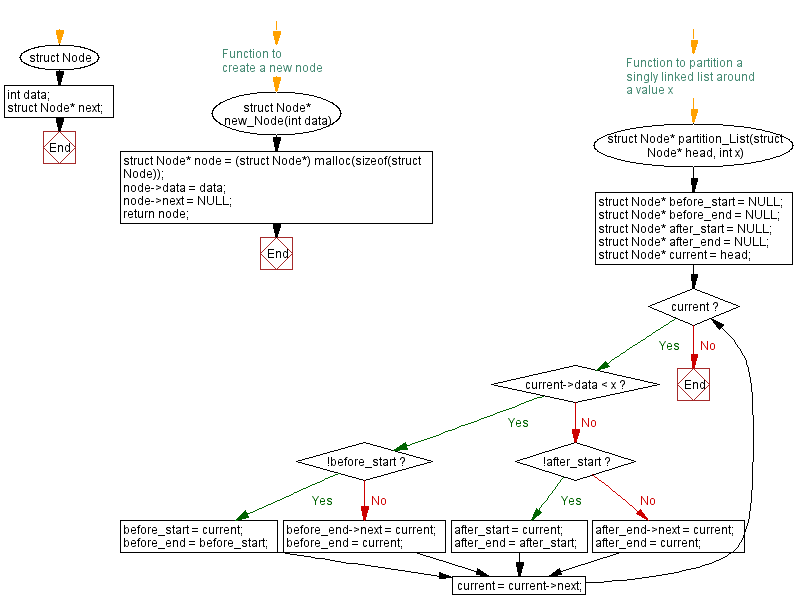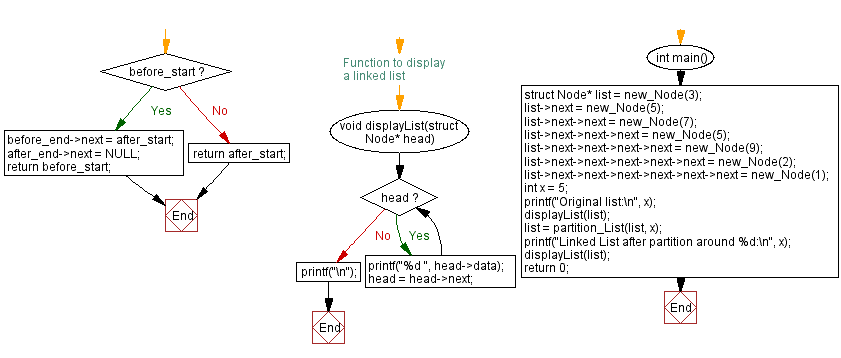C Exercises: Partition a singly linked list around a specific value
21. Partitioning with Dual Pivots
Write a C program to partition a singly linked list based on a specific value.
Sample Solution:
C Code:
#include<stdio.h>
#include <stdlib.h>
// Define a structure for a Node in a singly linked list
struct Node {
int data;
struct Node* next;
};
// Function to create a new node with given data
struct Node* new_Node(int data) {
// Allocate memory for a new node
struct Node* node = (struct Node*) malloc(sizeof(struct Node));
// Set the data for the new node
node->data = data;
// Set the next pointer of the new node to NULL
node->next = NULL;
return node;
}
// Function to partition a singly linked list around a given value x
struct Node* partition_List(struct Node* head, int x) {
struct Node* before_start = NULL;
struct Node* before_end = NULL;
struct Node* after_start = NULL;
struct Node* after_end = NULL;
struct Node* current = head;
// Traverse the linked list and partition nodes based on the value x
while (current) {
if (current->data < x) {
// Nodes less than x are added to the "before" partition
if (!before_start) {
before_start = current;
before_end = before_start;
} else {
before_end->next = current;
before_end = current;
}
} else {
// Nodes greater than or equal to x are added to the "after" partition
if (!after_start) {
after_start = current;
after_end = after_start;
} else {
after_end->next = current;
after_end = current;
}
}
current = current->next;
}
// Connect the "before" and "after" partitions and return the head of the partitioned list
if (before_start) {
before_end->next = after_start;
after_end->next = NULL;
return before_start;
} else {
return after_start;
}
}
// Function to display the elements of a linked list
void displayList(struct Node* head) {
while (head) {
printf("%d ", head->data);
head = head->next;
}
printf("\n");
}
// Main function where the execution starts
int main() {
struct Node* list = new_Node(3);
list->next = new_Node(5);
list->next->next = new_Node(7);
list->next->next->next = new_Node(5);
list->next->next->next->next = new_Node(9);
list->next->next->next->next->next = new_Node(2);
list->next->next->next->next->next->next = new_Node(1);
int x = 5;
printf("Original list:\n");
displayList(list); // Display the original list
list = partition_List(list, x); // Partition the list around the value x
printf("Linked List after partition around %d:\n", x);
displayList(list); // Display the partitioned list
return 0; // Indicates successful completion of the program
}
Sample Output:
Original list: 3 5 7 5 9 2 1 Linked List after partition around 5: 3 2 1 5 7 5 9
Flowchart :


For more Practice: Solve these Related Problems:
- Write a C program to partition a linked list into three segments based on two pivot values.
- Write a C program to partition a singly linked list into nodes less than, equal to, and greater than a given value while preserving the original order.
- Write a C program to recursively partition a linked list around a pivot value without using extra memory.
- Write a C program to partition a linked list and then reverse the segment of nodes greater than the pivot.
Go to:
PREV : Nth Node from End Variants.
Next: Linked List Addition Variants.
C Programming Code Editor:
Have another way to solve this solution? Contribute your code (and comments) through Disqus.
What is the difficulty level of this exercise?
